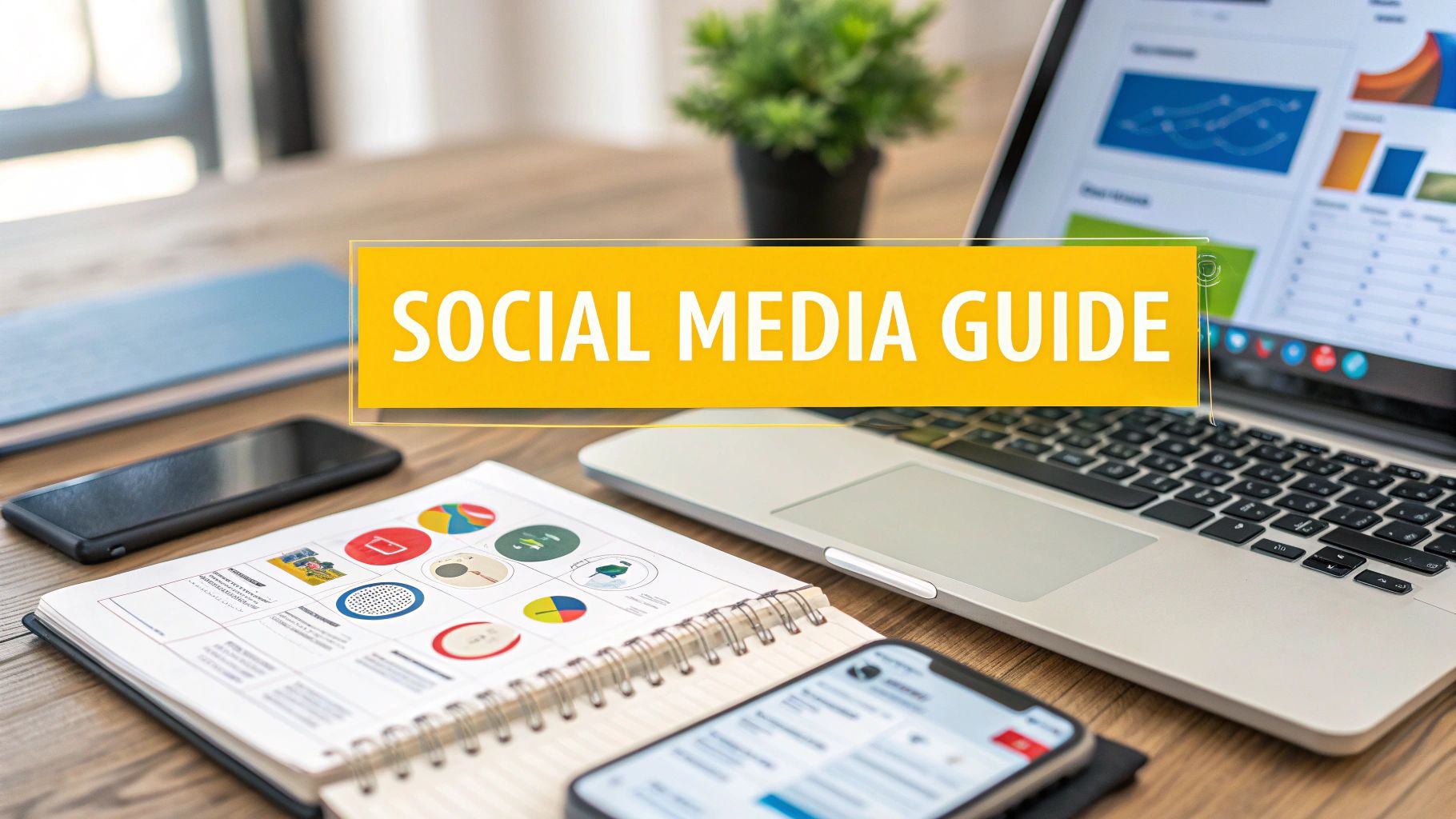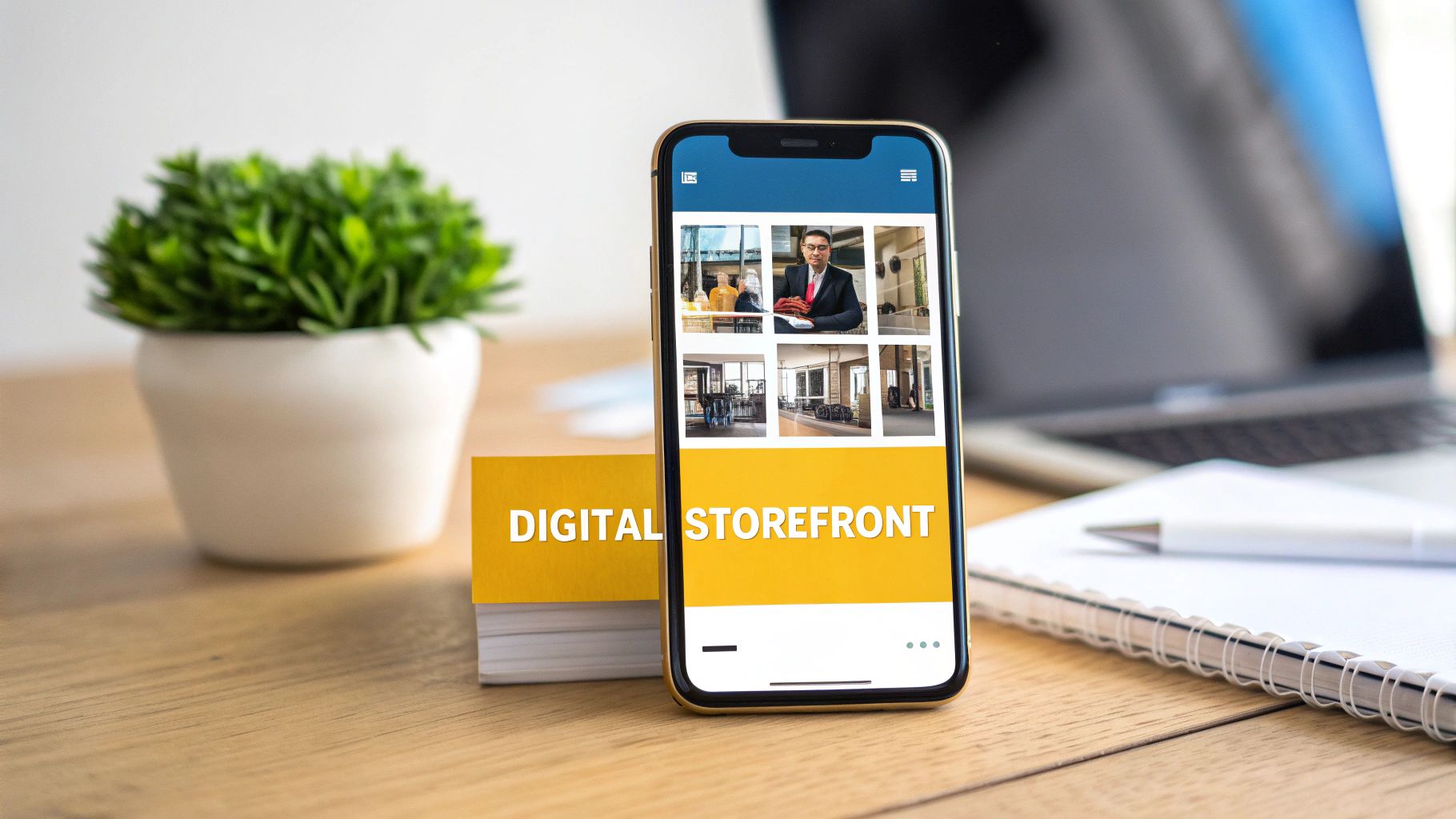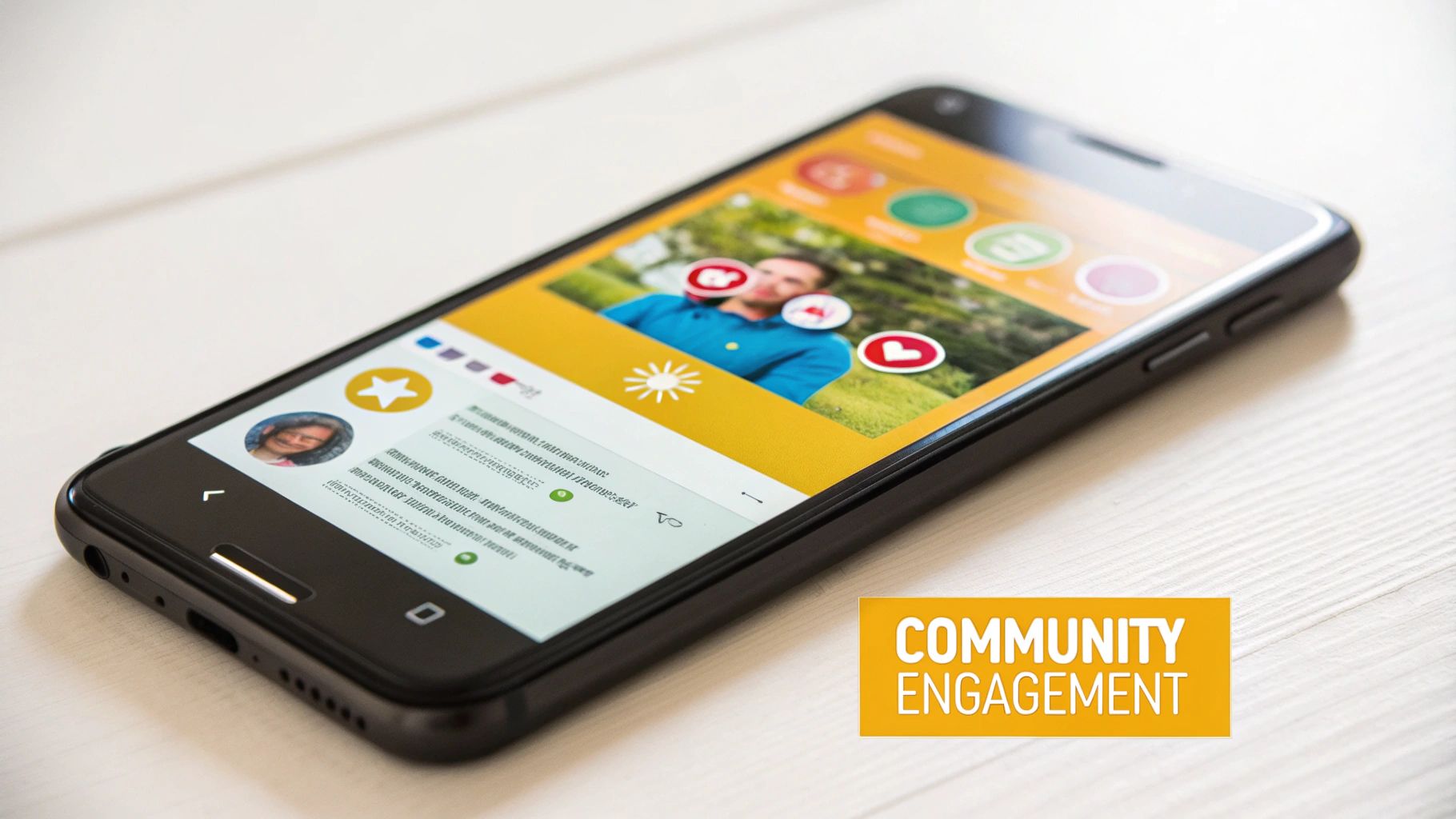Social Media Marketing for Small Business Guide

For a small business, social media marketing isn't just about posting updates on Facebook or Instagram. It’s about building a brand, genuinely connecting with your audience, and ultimately, driving sales. Think of it as the modern-day town square—a place where you can chat directly with your customers and turn casual followers into passionate fans, all without needing a giant marketing budget.
Why Social Media Is Your Digital Storefront

Imagine your social media profile as the new front door to your business. It’s often the very first place a potential customer will look you up, long before they ever click over to your website or walk into your shop. This isn't just a trend; it's a fundamental shift in how people discover and connect with brands.
Social media has completely changed the game. It's now the number one way people find new businesses. In fact, 58% of consumers around the world say they discover new brands on social platforms—that’s more than through traditional search engines. And when you consider that Facebook alone has over 3 billion monthly active users, it’s easy to see why 96% of small businesses are already using social media to market themselves.
The Core Benefits for Your Business
Getting good at social media isn't just about vanity metrics like likes and follows; it delivers real-world results that help your business grow. It’s about building a real asset.
- Build Authentic Brand Awareness: Social media lets you show off your business's personality. You can share your story and what you stand for, creating a genuine connection that a simple ad could never achieve. A great way to stay consistent is to understand how to create brand guidelines for your voice and visuals.
- Foster Genuine Customer Relationships: Every comment, message, and share is a chance to talk directly with your audience. These conversations build trust and can turn a one-time buyer into a loyal advocate who tells their friends about you.
- Drive High-Quality Website Traffic: When you share content that your followers find useful or interesting, you can lead them right to your website, blog, or product pages. This isn't just random traffic; these are people who are already warmed up to your brand.
- Generate Valuable Leads and Sales: Social platforms have become powerful sales tools. With features like shoppable posts and targeted ads, you can turn a user's interest into a sale without them ever having to leave the app.
Turning Platforms into Profit Centers
Each social media channel gives you a unique chance to set up a digital storefront. Your Instagram profile can act as a beautiful, browsable catalog, while your Facebook page can become a lively community hub filled with reviews and discussions.
For businesses that rely on visuals, like e-commerce or lifestyle blogs, learning how to use Pinterest for business can open up another massive opportunity.
When you start treating your social media profiles like dynamic, interactive storefronts, you're creating more doors for customers to walk through. You’re meeting them right where they already are and making it incredibly easy for them to connect and buy from you.
Choosing the Right Social Media Platforms

It’s easy to feel like you need to be everywhere at once on social media. The pressure is real. But here's some good news: you don't. In fact, you shouldn't. Smart social media marketing for small business isn't about blanketing every single platform; it's about making a real impact on the right ones.
Think of it like fishing. You wouldn’t just cast a giant net into the ocean and hope for the best. You'd go where you know the specific fish you want to catch are swimming. The same logic applies here. Your success hinges on focusing your limited time and resources where they’ll actually make a difference.
To cut through the noise and avoid burnout, let's break it down into three simple but critical questions. Your answers will point you straight to the platforms that are a perfect fit for your business.
H3: Where Does Your Audience Spend Their Time?
This is the big one. Honestly, nothing else matters if you're talking to an empty room. Your entire strategy works only if it reaches your ideal customer where they naturally hang out online.
If you sell specialized B2B software, your audience is almost certainly scrolling through LinkedIn, not TikTok. On the flip side, a boutique selling trendy clothes to Gen Z will find their tribe on TikTok and Instagram.
Start by sketching out a quick profile of your ideal customer. Think about:
- Age and Demographics: Different generations flock to different platforms. While Facebook has a massive user base across the board, TikTok’s audience is much younger.
- Interests and Hobbies: What do they love doing? A local bakery will find a hungry, engaged community on a visual-first platform like Pinterest, where people are actively looking for recipes and food inspiration.
- Professional Life: Are your customers C-suite executives, freelance creatives, or skilled tradespeople? LinkedIn is the undeniable king for professional networking and B2B marketing.
Once you know who you're talking to, you can immediately cross a few platforms off your list and focus your energy where it counts.
H3: What Is Your Natural Content Style?
Every platform has its own vibe and preferred format. Your ability to create content that feels native—not forced—will make or break your efforts. Are you a gifted storyteller on video, or do you shine when writing sharp, insightful text?
- Visually-Driven: If your business is photogenic—think food, fashion, travel, or design—then Instagram and Pinterest are your natural home. They are built from the ground up for stunning photos and graphics.
- Video-Focused: Short, snappy, and entertaining video reigns supreme on TikTok and Instagram Reels. If you're more into longer-form educational content like in-depth tutorials or product demos, YouTube is still the undisputed champion.
- Text and Community-Driven: If your strength is in sharing industry knowledge, sparking conversations, and building a community around ideas, then LinkedIn and Facebook Groups are incredibly powerful. X (formerly Twitter) is perfect for real-time updates and jumping into trending conversations.
Choosing a platform that plays to your content strengths makes the whole process sustainable. Remember, your social media activity should fit into a broader strategy. Using a digital marketing plan template can help you organize how your content on these platforms supports your overall goals.
H3: Aligning Platforms with Business Goals
Finally, what are you actually trying to accomplish? Your core business objective should be the ultimate filter for your platform choice. While many goals can overlap, some platforms are simply better built for certain outcomes.
The goal isn't just to be seen; it's to be seen by the right people in the right place, prompting the right action. Every platform offers a unique pathway to a different business objective.
A local plumber or café, for example, will want to build a strong community and gather reviews on Facebook to drive local business. An e-commerce brand, however, will likely pour its energy into Instagram and Pinterest, which have amazing features for visual product discovery and direct shopping.
To make this easier, I've put together a quick-reference table to help you match your goals to the right platforms.
Social Media Platform Selector for Small Businesses
This table is a simple guide to help you quickly see which platforms align with your target audience, content style, and primary business objectives. Use it as a starting point to narrow down your options.
| Platform | Primary Audience | Best Content Format | Ideal for Business Goal |
|---|---|---|---|
| Broad; multiple generations (especially Millennials & Gen X) | Text, images, video, community posts | Community building, local discovery, customer service | |
| Millennials & Gen Z | High-quality photos, Reels (short video), Stories | Visual brand building, product showcasing, e-commerce | |
| Professionals, B2B decision-makers, industry experts | Articles, text posts, professional video, case studies | B2B lead generation, establishing authority, recruitment | |
| TikTok | Gen Z & younger Millennials | Short-form, creative, and trending video | Brand awareness, reaching younger audiences, user-generated content |
| Primarily female users; interest-based (DIY, home, etc.) | High-quality vertical images ("Pins"), video Pins | Driving website traffic, e-commerce product discovery | |
| YouTube | Extremely broad and diverse | Long-form video (tutorials, reviews, vlogs) | In-depth education, product demonstrations, building trust |
| X (Twitter) | News junkies, professionals, tech, and media-savvy users | Short text ("Tweets"), real-time updates, threads | Breaking news, customer service, real-time engagement |
By thoughtfully weighing your audience, content, and goals, you can shift from a scattered, "do-everything" approach to a laser-focused strategy. This deliberate focus won't just save you a ton of time and headaches—it will deliver much better results for your small business.
Developing Your Winning Content Strategy

Knowing where to post is just the first step. The real magic happens when you nail down what to post. A smart content strategy is the engine that drives your social media, making sure every post you share has a purpose and speaks directly to the people you want to reach.
Without a plan, you're basically just throwing content at the wall and hoping something sticks. With a strategy, you're methodically building a library of valuable, relevant posts that position you as an expert and create a community of loyal followers. It’s about moving from random updates to creating consistent themes.
Establish Your Core Content Pillars
The foundation of any solid strategy is a handful of content pillars. Think of these as three to five core topics your business will consistently own and talk about. These themes should sit at the intersection of your industry, your audience’s interests, and the problems your business solves.
Let's take a local coffee shop as an example. Their content pillars might look like this:
- Coffee Education: Simple posts explaining brewing methods, the story behind their beans, or even fun latte art tutorials.
- Behind the Scenes: Content that shows the real people and processes—baristas at work, the owner's daily routine, or how they roast their beans.
- Community Spotlight: Featuring local artists whose work hangs on their walls or cross-promoting events happening down the street.
- Product Features: Highlighting seasonal drinks, fresh pastries, or special promotions in a way that feels special, not salesy.
These pillars guarantee their content is always on-brand and gives followers a reason to keep coming back. Everything they post works together to tell a bigger story.
A Mix of Engaging Content Types
Once your pillars are in place, it’s time to fill them with different types of content to keep things from getting stale. Nobody wants to see the same kind of post day after day. A healthy variety is what keeps people engaged.
To get the hang of this, it's worth taking a moment to explore content creation fundamentals. For now, here are a few key formats to mix into your strategy:
- Educational Posts: How-to guides, quick tips, and tutorials that genuinely help your audience. This is how you build trust and become their go-to resource.
- Behind-the-Scenes Glimpses: Show off the human side of your business. This kind of authentic content makes people feel like they know you.
- User-Generated Content (UGC): Share photos or testimonials from happy customers (with their permission, of course!). This is powerful social proof that shows real people love what you do.
- Promotional Content: This is where you talk about what you're selling. It’s essential, but it should be sprinkled in, not dominate your feed.
The Unstoppable Power of Video and Authenticity
Let's be clear: video content isn't optional anymore. An incredible 78% of consumers say they prefer learning about products through short video clips. On Facebook alone, video posts can rack up 600% more engagement than static images.
But here’s the thing: algorithms have gotten smarter. They now prioritize genuine interaction, which means authenticity is your most valuable currency. Your audience wants to connect with the real you. If you need a little spark, our guide has tons of social media content ideas to get your creativity flowing.
Your social media should feel less like a polished advertisement and more like a genuine conversation. Authenticity is what builds the trust that algorithms—and audiences—reward.
Plan for Consistency with a Content Calendar
A brilliant strategy is useless if you can't execute it consistently. This is where a simple content calendar saves the day. It doesn’t have to be fancy—a basic spreadsheet or a free app works perfectly.
Just map out your posts a week or two ahead of time. Note the date, which content pillar it fits, the format (like a Reel, photo, or Story), and a rough draft of the caption. This simple tool takes the daily pressure off, helps you maintain that all-important content mix, and ensures you're always showing up for your audience. A little planning goes a long way.
How to Build an Engaged Community

Let's be clear: a big follower count doesn't mean much if no one is listening. The real magic happens when you turn that passive audience into a lively, engaged community. You need to stop thinking like a broadcaster and start acting like the host of a great party. Your job is to get people talking and make them feel like they belong.
This shift—from posting at people to talking with them—is the secret sauce for building real loyalty. When people feel seen and heard, they stick around. They become advocates. This is the heart of effective social media marketing for small business; it's all about building genuine relationships.
The Art of Sparking Conversation
Every post you make is a chance to connect. Instead of just listing facts about your product, write captions that practically beg for a response. The idea is to make your content interactive, not just a one-way announcement.
Start by asking easy, open-ended questions. For instance, a local coffee shop could post a picture of a latte and ask, "What’s your go-to drink on a Monday morning?" That simple tweak invites participation and turns a passive scroll into a moment of connection.
You can also lean on the interactive features built right into the platforms. They're designed to get people involved with a simple tap.
- Run Polls and Quizzes: Use Instagram Stories or X (formerly Twitter) polls to get quick opinions on new product ideas, industry trends, or just fun, lighthearted topics.
- Host Q&A Sessions: Set aside time for an "Ask Me Anything" session. It pulls back the curtain on your business, builds trust, and positions you as a helpful expert.
- Create "Fill-in-the-Blank" Posts: These low-effort prompts are surprisingly great at getting people to drop a comment. A simple "My favorite thing about fall is ______" can get the ball rolling.
These tactics make your brand feel more human and approachable, which makes it far easier for people to jump into the conversation.
Responsiveness Is Your Superpower
Imagine you ask the host a question at a party, and they just smile and walk away. You’d feel pretty ignored, right? It’s the exact same feeling online. Responding quickly to comments and direct messages is one of the most impactful things you can do.
In fact, research shows that almost 80% of consumers are more likely to buy from a brand after a positive social media experience. Your responsiveness isn't just good manners; it's smart business. It proves you value your community and are actually listening.
Think of every comment and message as an opportunity. It’s a chance to strengthen a relationship, solve a problem, or turn a curious follower into a loyal customer. Never leave a conversation hanging.
Try to respond to all legitimate comments and messages within a few hours. This one simple habit builds an incredible amount of trust and goodwill, showing everyone there's a real, caring person behind the logo.
Handling Negative Feedback with Grace
Sooner or later, you'll get a negative comment. It's inevitable, and honestly, it's okay. When handled the right way, negative feedback is a golden opportunity to show everyone just how much you care about customer satisfaction.
Whatever you do, don't just delete negative comments (unless they're spammy or truly offensive). Hitting delete makes it look like you have something to hide. Instead, follow this simple three-step playbook for a graceful recovery.
- Acknowledge and Empathize: Start by responding publicly. A simple, "We're so sorry to hear you had this experience" shows you're listening and you care.
- Take it Offline: Immediately offer to solve the issue in a private channel. Say something like, "We want to make this right. Could you please send us a DM with your order details so we can look into this for you?"
- Learn from It: Treat the feedback as free consulting. Often, one person's public complaint is highlighting a hidden problem that many other customers are experiencing quietly.
By tackling criticism head-on, you don't just fix a problem for one person. You show your entire audience that you're accountable and dedicated to getting it right. That kind of transparency can turn even the loudest critic into a loyal fan.
How to Know if Your Social Media is Actually Working
It feels great to post awesome content and watch your community grow. But here's the million-dollar question: is any of it actually making a difference for your business? Flying blind on social media, without looking at the numbers, is like trying to navigate a new city without a map. You need data to steer you in the right direction.
For a lot of small business owners, the word "analytics" is enough to make their eyes glaze over. But it doesn't have to be a confusing mess of charts and graphs. Let’s cut through the noise and focus on three simple categories that tell you everything you need to know.
Are People Seeing Your Stuff? (Awareness)
First things first: is anyone even seeing your posts? This is all about Awareness. Think of it as people noticing your shop as they walk down the street. If they don't see you, they can't come in. These numbers tell you how visible your brand is.
Two key metrics will give you the answer:
- Reach: This is the simplest one. It’s the total number of unique individuals who saw your post. If 1,000 people laid eyes on your latest Instagram Reel, your reach is 1,000. It's a clean measure of how far your content is spreading.
- Impressions: This number tracks how many times your content was shown on a screen. One person might see your post in their feed three separate times—that counts as 1 for reach, but 3 for impressions. A high impression count means the platform is showing your content around a lot.
You can easily find this info right inside the analytics tools provided by platforms like Meta Business Suite or TikTok Insights. If your reach is growing week over week, you're doing something right.
Are People Paying Attention? (Engagement)
Okay, so people are seeing your content. The next big question is... do they care? This is where Engagement comes into play. These metrics prove that people aren't just scrolling past your posts like digital wallpaper. They're actually stopping and interacting.
Engagement is the currency of social media. It's proof that you’re building a real connection, not just shouting into an empty room.
Here’s what to look for:
- Likes, Comments, and Shares: The classics! These are direct signals that someone found your content interesting. Comments are especially golden—they mean someone was moved enough to stop, think, and type out a response.
- Saves: When someone hits "save" on a post, it's a huge compliment. It means your content was so valuable or inspiring that they want to refer back to it later.
- Engagement Rate: This is the holy grail. To find it, you just take the total number of engagements (likes + comments + shares, etc.), divide it by your reach, and multiply by 100. An engagement rate of 3-6% is generally considered pretty solid and tells you that your content is a big hit with your audience.
A post with monster engagement is a blueprint. It’s your audience telling you, "Hey, make more stuff just like this!"
Are People Taking Action? (Conversions)
Now we get to the bottom line. Getting likes and comments is great for the ego, but as a small business, you need your social media work to lead to something more. This is the Conversion category. It’s all about tracking whether your followers are doing what you want them to do.
These are the metrics that connect your social media marketing for small business directly to your cash register.
- Click-Through Rate (CTR): This is the percentage of people who saw your post and actually clicked on the link you provided. A strong CTR shows that your call-to-action was compelling enough to get someone to leave the social media app and head to your website or online store.
- Conversions: This is the ultimate win. A conversion is when someone completes the goal you set, whether that’s buying a product, signing up for your email list, or filling out a contact form.
To track these properly, you’ll need to set up tools like the Meta Pixel or use special tracking links with UTM parameters. It might sound a bit technical, but taking this one extra step is what turns social media from a "nice-to-have" into a predictable engine for growth. It’s how you can confidently say, "We put in the work on social media, and it brought us X number of new customers."
Alright, let's talk about putting some money behind your social media efforts. While building an organic following is crucial for community, sometimes you need to give your best content a serious push to get it in front of new eyes.
This is where paid social advertising comes in. It’s your fast track past the algorithm, letting you place your message directly in the feeds of people who are most likely to become your next customers.
Think about that one post that really took off—the one with all the likes, comments, and shares. Now, what if you could pay a little bit to show that exact same post to 5,000 more people who fit the profile of your ideal customer? That’s the magic of paid ads.
Boosting a Post vs. Running a Real Ad Campaign
You’ve definitely seen that big blue "Boost Post" button staring at you on Facebook and Instagram. It's tempting because it's so easy, but boosting is really just scratching the surface of what's possible. A dedicated ad campaign gives you so much more control, which means your money works a lot harder for you.
Think of it this way: Boosting a post is like using a sprinkler—you'll hit a wide area, but you can't control exactly where the water lands. A real ad campaign is more like a precision drip irrigation system—you deliver the right message directly to the right person at the right time.
With a proper campaign, you can get incredibly specific about who sees your ad, where they see it, and what action you want them to take. That level of precision is how you get a real return on your ad spend.
The Three Pillars of Your First Ad Campaign
Diving into ads doesn’t have to feel overwhelming. A solid, effective ad campaign really just comes down to three core components. Get these right, and you'll have a strong foundation for success.
Figure Out Your Goal: First things first, what are you actually trying to accomplish? Don't just throw money at an ad without a clear purpose. Are you trying to get more people to visit your website? Do you want to capture email addresses for your newsletter? Or are you aiming to sell a specific product right then and there?
Pinpoint Your Audience: Who, exactly, are you trying to talk to? The ad tools on platforms like Facebook and Instagram are incredibly powerful. You can target people based on their location, age, and interests (like "coffee lovers" or "DIY home decor"), and even their recent online activities.
Set a Smart Budget: You don't need a huge wallet to get started. You can genuinely begin to see what works with as little as $5 per day. The key is to set a firm daily or total campaign budget so you stay in control while you test and learn.
Frequently Asked Questions
Jumping into social media for your business can bring up a lot of questions. Let's tackle some of the most common ones I hear from small business owners so you can move forward with confidence.
How Much Should a Small Business Spend on Social Media?
This is probably the biggest question on everyone's mind. The honest answer? Your most significant investment won't be money—it will be your time. Seriously. Building a genuine community and creating content that people actually want to see is where the real work is.
When you're ready to dip your toes into paid ads, you don't need to break the bank. You can start getting a feel for what works with as little as $5 to $10 per day. Think of it as a small-scale experiment, not a massive financial risk.
As a general rule of thumb, many small businesses put about 2-5% of their total revenue toward their entire marketing budget, and a slice of that goes to social media.
Your budget is a mix of two critical resources: time for organic community building and money for targeted ad campaigns. Start by investing your time wisely, then strategically add a small ad spend to amplify your best-performing content and reach new audiences.
How Often Should I Post on Social Media?
Let's get one thing straight: quality trumps quantity, every single time. Flooding your followers' feeds with so-so posts is a fast track to getting unfollowed. The goal is to be a consistent source of value, not just noise.
For most small businesses, posting 3-5 times per week on your main platform is a fantastic starting point. It's enough to keep you on your audience's radar without completely burning you out.
Of course, the "right" number changes a bit depending on where you're posting:
- Instagram and Facebook: Aim for 3-5 solid, high-quality posts a week.
- X (formerly Twitter): Things move faster here. 1-3 posts a day can work well if you have the content for it.
- LinkedIn: It’s all about professional value. 2-4 insightful posts per week usually hits the sweet spot.
Whatever you choose, the most important thing is to pick a schedule you can actually stick with for the long haul. Consistency is key.
What Are the Best Tools to Manage Social Media?
Trying to manage multiple social media accounts manually is a recipe for a headache. Thankfully, there are some great tools out there that can save you hours each week by letting you schedule posts ahead of time, check your results, and see everything in one place.
If you're just starting out, you don't need a complicated, expensive system. Here are a few great options to get you going:
- Meta Business Suite: This is Meta's own free tool for managing your Facebook and Instagram accounts. You can schedule posts and check basic performance without spending a dime.
- Buffer: People love Buffer for its simple, clean design. It makes scheduling content and seeing how it performs incredibly straightforward.
- Hootsuite: If you're looking for a bit more power, Hootsuite is a do-it-all platform with in-depth scheduling, social listening, and detailed analytics to help you grow.